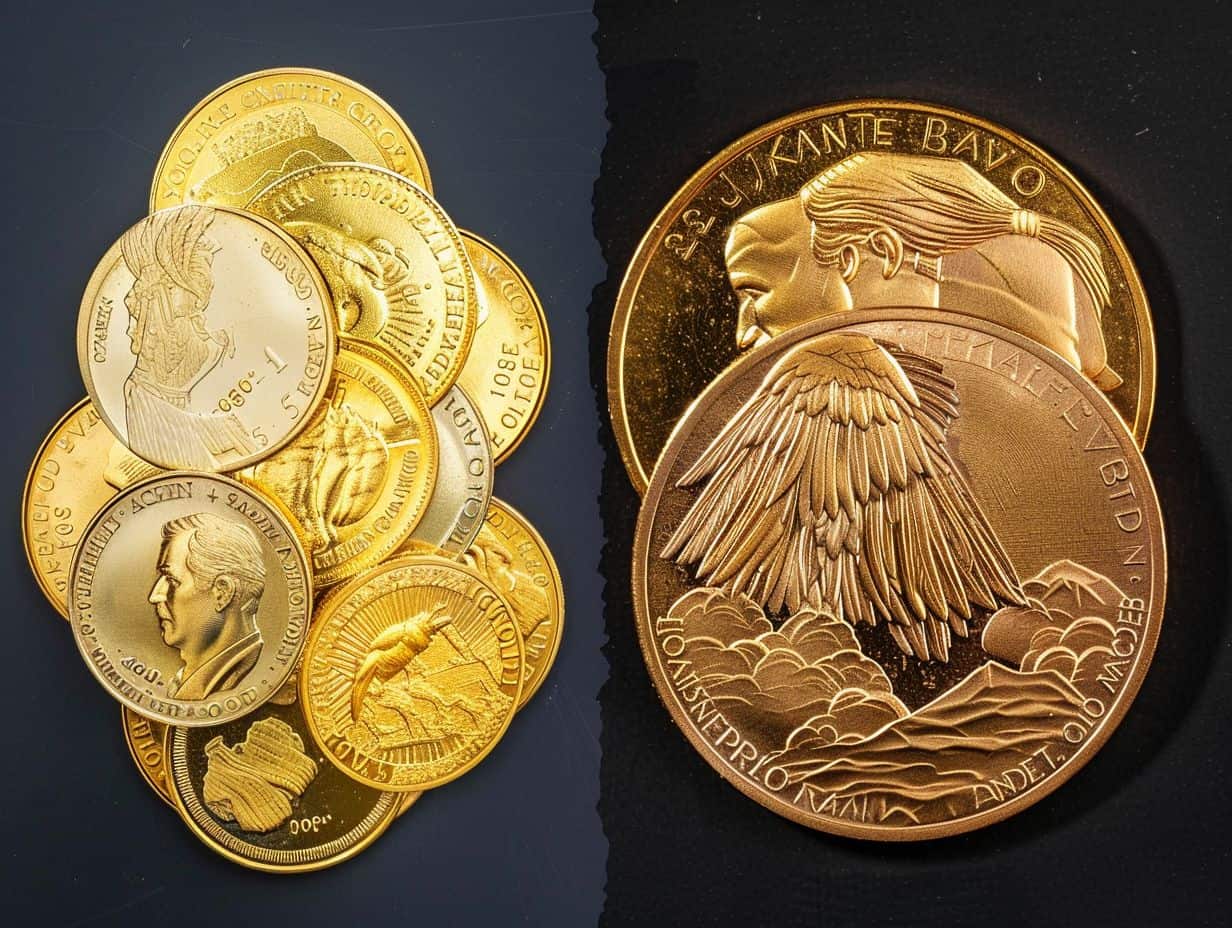- Our content is independently written and reviewed by trusted reviewers & fact-checkers.
- Your information is never sold. We can earn money by connecting you with top Gold IRA Companies. Learn how our reviews work.
- Want to learn more? Meet our authors and explore our editorial policy.
Considering investing in gold but unsure whether to choose bullion or coins?
We break down the key differences between gold bullion and coins, including their definitions, characteristics, costs, storage options, collectibility, and liquidity.
By comparing these two popular forms of gold investment, you will gain a better understanding of which option may be best suited to your investment goals.
Stay tuned to make an informed decision on whether to invest in gold bullion or coins!

Table of Contents
Key Takeaways:
- Gold bullion and coins are both considered as gold investments, but they have distinct differences in terms of cost, storage options, collectibility, and liquidity.
- Gold bullion is defined as pure gold in the form of bars or ingots, while gold coins are legal tender with a specific weight and purity.
- When choosing between gold bullion and coins, consider your investment goals, budget, and storage options to determine which option is best for you.
Understanding Gold Investments
Gold investments offer a variety of options, ranging from physical gold like gold bars and coins to gold ETFs and futures contracts. Investors have the flexibility to buy and sell gold in different forms, each presenting unique advantages and considerations within the dynamic gold market.
Physical gold, such as coins and bars, provides investors with tangible assets that can be securely stored. In contrast, Gold ETFs offer a way to invest in gold without the requirement of physical storage. Futures contracts provide trading opportunities for speculating on the future price of gold.
The price of gold is influenced by factors like inflation, economic stability, and geopolitical events. Including gold in a diversified investment portfolio can serve as a hedge against economic uncertainties.
Gold Bullion
Gold bullion, such as gold bars, is considered one of the purest forms of physical gold investment due to its high purity and standardization. These characteristics make it a popular choice for investors seeking to diversify their portfolios with tangible assets.
Gold bars are typically refined to a fineness level of .9999, ensuring they consist of nearly pure gold. This level of purity guarantees the underlying value of the bullion. Furthermore, standardization adds to the appeal of gold bars as they are manufactured in various sizes and weights, facilitating easy trading across international markets.
Regarding storage options, investors have the choice of secure vaults, safety deposit boxes, or specialized storage facilities. The liquidity of gold bars is another advantageous aspect, as buyers are readily available in both physical and digital markets. Including gold bullion in a diversified investment portfolio offers a hedge against economic uncertainties and aids in wealth preservation over the long term.
Definition and Characteristics
Gold bullion, which includes gold bars, is characterized by its high purity and weight, typically ranging from 1 gram to 1 kilogram. Investors appreciate bullion for its inherent value and utilize it as a crucial element in diversifying investment portfolios.
The high purity of gold bullion, often exceeding 99.9%, ensures its value and reputation in the market. Weight variances enable investors to select the size that aligns with their investment objectives, offering small denominations for retail investors and larger bars for institutional buyers.
The attractiveness of gold bullion lies in its stability as a safe-haven asset, providing protection against economic uncertainties and inflation. This precious metal’s intrinsic value has been historically acknowledged, establishing it as a favored option for investors looking to safeguard and enhance their wealth over time.
Cost
The price of gold bullion, whether in the form of gold bars or coins, varies based on market conditions and demand. Investors can purchase and sell gold at current market prices, which are influenced by factors such as economic indicators and geopolitical events.
Market dynamics and global events are significant factors in determining the value of gold. For example, during times of economic uncertainty, gold is often considered a safe-haven asset, leading to an increase in demand and consequently higher prices. Conversely, periods of economic stability may result in lower gold prices. Central bank policies, inflation rates, and currency fluctuations also affect the price of gold. Understanding these various factors is crucial for investors seeking to navigate the complexities of the gold market.
Storage Options
Selecting the appropriate storage options for gold bars is crucial to ensure their safety and preservation over time. Investors have a range of choices, from personal safes to specialized facilities, each providing varying levels of security and accessibility.
Security is a primary consideration in storing gold bars, given their value as assets that require safeguarding. Personal safes can offer a convenient option for individuals who prefer to keep their gold close at hand, but they may not provide the same level of security as specialized facilities.
In contrast, secure facilities are equipped with advanced security measures such as surveillance cameras, access control, and continuous monitoring, making them a popular option for investors seeking maximum protection. These facilities often come with insurance coverage, offering an additional layer of security for the stored assets.

Liquidity
Gold bars and coins provide investors with a high degree of liquidity, enabling them to easily trade these assets in the gold market.
This tradability within the gold market is essential for portfolio diversification and risk management strategies. By possessing physical gold, investors benefit from the ability to swiftly convert their holdings into cash when required, thereby offering a level of protection against market fluctuations. The efficient liquidation of gold assets also enhances the attractiveness of including this precious metal in investment portfolios, as it presents a tangible and dependable form of wealth that can act as a hedge against inflation or economic uncertainties.
Gold Coins
Gold coins, such as Philharmonic Coins, Maple Leafs, and American Gold Eagle coins, are favored by investors for their combination of intrinsic value and collectibility. These physical gold assets are commonly chosen by those seeking to broaden their investment portfolios.
The appeal of gold coins goes beyond their financial value; these iconic pieces often carry historical and cultural significance. For instance, American Gold Eagle coins are not just valued for their gold content but also for their patriotic designs featuring iconic American symbols. Their limited production and intricate craftsmanship make them highly desirable among collectors and investors.
In terms of storage, investors have various options, from home safes to specialized vault services, to protect their investments in gold coins. Including gold coins in a diversified portfolio can serve as a hedge against economic uncertainties and inflation, providing a wealth store that has proven its resilience over time.
Definition and Characteristics
Gold coins, valued for their historical importance and visual appeal, are highly sought after by investors due to their inherent value and collectible nature. These physical gold assets are available in a variety of designs and denominations to cater to a range of investor preferences.
Gold coins have a long and diverse history that spans centuries, representing wealth and influence throughout various civilizations. The intricate designs on each coin showcase the skill of the minting process, enhancing their attractiveness.
Investors appreciate the tangible quality of gold coins, offering a sense of stability during market volatility. Collectors are interested in rare and limited edition gold coins for their individuality, contributing to a lively numismatic market.
With options ranging from ancient coins to modern bullion, there is a diverse selection available to appeal to collectors and investors of all kinds.
Cost
The price of gold coins is subject to fluctuations based on various factors like design complexity, rarity, and demand in the gold market. Investors engage in buying and selling gold coins at prices that are influenced by market conditions and collector preferences.
Gold coins that feature intricate designs or have limited minting can fetch higher prices because of their aesthetic appeal and scarcity. The rarity of a gold coin is a significant factor in determining its value, with vintage or historical pieces often commanding premium prices. Market demand also plays a role in pricing, as shifts in the global economy can impact investor sentiment towards precious metals.
When purchasing or selling gold coins, it is important to stay informed about market trends and evaluate the current demand-supply dynamics to make well-informed decisions for maximizing returns.
Storage Options
Selecting appropriate storage options is essential for maintaining the condition and collectibility of gold coins. Investors have a range of options, such as display cases and secure vaults, each providing varying degrees of protection and visibility for their coin collections.
Display cases are commonly used for exhibiting gold coins while safeguarding them from dust and physical harm. For extended storage periods, investors might choose secure vaults that provide the highest level of protection against theft and environmental elements. When choosing a storage option, it is crucial to consider factors like humidity control, temperature stability, and security measures to ensure the coins retain their value and visual appeal over time.
Collectibility
The collectibility factor of gold coins adds a unique dimension to their investment appeal, attracting both investors and numismatic enthusiasts. Rare and limited-edition coins hold significant value beyond their gold content, making them sought after for their historical and aesthetic value.
These rare and limited-edition gold coins often have intriguing stories behind them, such as being minted in limited quantities or featuring unique designs. The allure of owning a piece of history or a one-of-a-kind coin drives collectors to seek out these prized possessions. The scarcity of such coins in the market further elevates their desirability and investment potential, as their value can appreciate significantly over time due to their rarity and historical significance.

Liquidity
Gold coins provide investors with a high level of liquidity, facilitating simple buying and selling transactions. This tradability and widespread market acceptance of gold coins make them a valuable asset for investors seeking portfolio diversification. By integrating gold coins into their investment approach, individuals can introduce a degree of stability and flexibility to their holdings.
The liquidity of gold coins enables investors to promptly adapt to market changes or adjust their portfolios as required. The ease of converting gold coins into cash or other assets demonstrates their enduring appeal and practicality in the current investment environment.
Comparing Gold Bullion and Coins
When comparing gold bullion, such as gold bars and gold coins, investors should consider various factors. These include differences in cost, storage requirements, collectibility appeal, and liquidity advantages. Each type of physical gold presents distinct pros and cons for investment portfolios.
Gold bullion, in the form of bars, generally has lower premiums over the spot price compared to coins. This makes it a cost-effective choice for investors looking for direct exposure to the metal.
Gold coins, such as numismatics or rare historical coins, may hold higher collectibility value, which can attract both collectors and investors.
In terms of storage, bars are typically more space-efficient. On the other hand, coins often come in protective cases, adding to their appeal for collectors and making handling easier.
Regarding liquidity, both forms of gold can be easily traded. However, coins may offer greater flexibility due to their broader recognition and range of sizes.
Cost Differences
The cost difference between gold bars and coins varies based on factors such as weight, design intricacy, and market demand. Understanding these cost differentials is essential for investors looking to make informed decisions about their gold investments.
Gold bars typically come in larger weights compared to coins, which can influence their pricing per unit weight. The design complexity of coins, especially limited edition or collector coins, can add a premium to their cost. Market demand plays a critical role in dictating the pricing variations between gold bars and coins. When the demand for coins is high due to factors like numismatic value or historical significance, their prices may exceed those of gold bars in the same weight category.
Storage Considerations
The storage considerations for gold bars and coins vary depending on their sizes, weights, and the preferences of investors. Selecting the appropriate storage options is essential for preserving the condition and value of these physical gold assets over time.
Factors such as the purity of the gold, environmental conditions, and security measures also play significant roles in determining the suitable storage solutions. For example, smaller gold coins may require specialized protective holders or capsules to prevent scratching and damage during handling. In contrast, larger gold bars may necessitate secure vaults or safes due to their size and weight.
Investors commonly choose personalized storage services that provide secure facilities, insurance coverage, and regular audits to ensure the safety and integrity of their precious metal investments.
Collectibility Factor
The collectibility factor is a significant element that distinguishes gold bars from coins. Coins are often valued for their numismatic worth and historical importance. Investors who are drawn to the historical and aesthetic aspects of gold assets may prefer coins because of their collectibility.
Gold coins have an appeal beyond their intrinsic value determined by weight and purity. They attract collectors due to limited mintages, distinctive designs, and connections to significant historical events. For certain coins, the numismatic value can far surpass their gold content, which appeals to investors who value the rarity and historical significance embodied in these pieces. The collectibility aspect adds complexity to investment choices, as individuals need to consider potential price appreciation along with the emotional and historical connection that rare coins provide.
Liquidity Comparison
When comparing the liquidity of gold bars and coins, both forms provide investors with tradability and market acceptance. Understanding the liquidity distinctions between gold bars and coins is crucial for investors aiming to optimize their portfolio liquidity and flexibility.
Gold coins typically exhibit higher liquidity than gold bars because of their smaller denominations, which make them easier to purchase, sell, and trade in the market. The divisibility and recognizability of coins improve their tradability, appealing to a broader range of buyers and sellers.
Conversely, while gold bars may have lower liquidity in immediate transactions, they are favored for larger investments and storage purposes. Factors like purity, weight, and brand reputation also impact the market acceptance and liquidity of physical gold assets.

Choosing Between Gold Bullion and Coins
When deciding between gold bullion options like gold bars and gold coins, various factors should be considered, including personal preferences, investment goals, and risk management strategies. Investors need to weigh the unique advantages and considerations of each type of physical gold before selecting the option that best aligns with their financial objectives.
Gold bars are typically preferred by investors who want larger quantities of gold in a compact and efficient form. These bars are valued for their easy storage and strong retention of worth.
In contrast, gold coins are appealing to individuals interested in collectible items or smaller units of gold that are easier to trade. Along with their gold content, coins often have numismatic value, making them attractive to collectors and investors seeking diversity and historical significance in their portfolios.
Frequently Asked Questions
What is the difference between gold bullion and coins?
Gold bullion refers to any pure gold bars, ingots, or coins that are primarily used for investment or storage purposes. Coins, on the other hand, are legal tender coins that have a specific face value and may also have historical or collectible value.
Which one is a better investment: gold bullion or coins?
Both gold bullion and coins can be good investments, but they serve different purposes. Gold bullion is usually purchased for its intrinsic value and is considered a hedge against inflation and economic uncertainty. Coins, on the other hand, can offer a potential for appreciation in value due to their rarity or collectibility.
Are gold bullion and coins priced differently?
Yes, gold bullion and coins have different pricing structures. Gold bullion is typically priced based on the current spot price of gold, while coins may have a premium added to their value based on factors such as rarity, age, and historical significance.
Can I buy gold bullion and coins from the same place?
Yes, there are many dealers and companies that offer both gold bullion and coins for purchase. However, it’s important to do your research and make sure you are purchasing from a reputable source.
What are the storage options for gold bullion and coins?
Gold bullion and coins can be stored in a variety of ways, including at home in a safe, in a bank safe deposit box, or in a secure storage facility. It’s important to consider the potential risks and costs associated with each option before deciding on a storage method.
Can I use gold bullion and coins for everyday transactions?
No, gold bullion and coins are not intended for use in everyday transactions. Coins, however, can be used as legal tender and can be exchanged for their face value at banks or other financial institutions.














